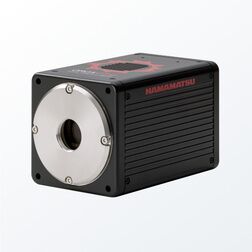ORCA-Fire high-speed qCMOS camera, in a nutshell
Integrating all the essential elements of a high performance, back-thinned, scientific CMOS (sCMOS) camera, the ORCA-Fire qCMOS camera offers low-noise, high quantum efficiency technology. Achieve excellent resolution, very high speed, and high sensitivity. The ORCA-Fire excels when the science demands high throughput, but the sample can only deliver a few photons.
ORCA-Fire high speed qCMOS camera, in more details
Small pixels, big resolution
Imaging below 40× magnification offers the advantage of large field of view, which can be critical for applications requiring high throughput. To acquire low magnification images with maximum information, the imaging system must achieve high resolution by matching pixel size to Nyquist-level or higher sampling rates. The pixel size of the ORCA-Fire qCMOS is ideal for most 40× objectives or lower, as outlined below.
* Rayleigh criterion (δ) = 0.61λ / NA
* Wavelength (λ) = 550 nm
* Δ = δ × Magnification of objective lens
High spatial resolution combined with a large pixel array and high speed readout delivers 2.9× higher pixel throughput over even the fastest 4.2 MP 6.5 μm sCMOS camera, and 40x higher pixel throughout over standard EMCCD cameras. Furthermore, at low magnification, the smaller pixel size of the ORCA-Fire reveals much more details than any of those two cameras technologies, as illustrated in the images below.
High QE & low noise
Using advanced back-thinned technology with micro-lenses, the ORCA-Fire achieves high quantum efficiency. Combined with readout noise of 1.0 e- rms, the ORCA-Fire offers paramount sensitivity at all light levels.
High quantum efficiency (QE) is a critical component of high sensitivity imaging. Achieving high QE through sensor back-thinning seems straightforward, but there are aspects of back-thinned sensor design that can impact image quality. In conventional back-illuminated detectors, crosstalk occurs between pixels due to poor pixel separation within the active region of the silicon, impairing resolution independent of pixel size. The ORCA-Fire qCMOS possesses a deep trench pixel structure that prevents pixel crosstalk and improves resolution.
Large field of view
With 4432 (H) × 2368 (V) pixels, the ORCA-Fire can effectively utilize a 22 mm microscope field of view.
Lightsheet Readout Mode [PATENTED]
In the field of biological research, fluorescence lightsheet microscopy has emerged as a favored technique for observing dynamic processes within living cells and organisms, as well as for capturing detailed 3D imagery of clarified tissue samples. While various iterations of lightsheet microscopy exist, the fundamental principle involves illuminating the sample orthogonally with a thin “sheet” of light. This illuminated sheet is then scanned across the sample, capturing optical cross-sectional images that can later be reconstructed into comprehensive 3D renderings. The ORCA-Fire qCMOS implements Hamamatsu’s patented lightsheet readout mode, during which the lightsheet is synchronized with readout of the sensor, reducing the impact of scattered light and effectively improving image quality and signal to noise.
In the ORCA-Fire, lightsheet readout has four distinct operational modes: forward, backward, bidirectional and reverse bidirectional. In forward mode the readout begins at the top and progresses to the bottom of the sensor. In backwards mode, the readout is initiated from the bottom and ends at the top. Bidirectional mode begins with forward readout in the first frame and switches to backwards readout in the next frame, continuing this alternating pattern frame by frame. As the name suggests, backwards bidirectional mode, begins with the bottom to top backwards readout in the first frame and switches to top to bottom in the next and so on. Both bidirectional modes were implemented to avoid the lag time required to return to the lightsheet to the top or bottom of the sensor for the next frame.
Click HERE to view more high speed cameras.
To view the manufacturer’s website, click HERE.
Hamamatsu Camera Line Up Catalog
Publications with ORCA-Lightning (predecessor of ORCA-Fire):
- Large-scale voltage imaging in behaving mice using targeted illumination. Sheng Xiao, Eric Lowet, Howard J. Gritton, Pierre Fabris, Yangyang Wang, Jack Sherman, Rebecca A. Mount, Hua-an Tseng, Heng-Ye Man, Christoph Straub, Kiryl D. Piatkevich, Edward S. Boyden, Jerome Mertz & Xue Han. iScience. November 2021.
- An experimental system for time-resolved x-ray diffraction of deforming silicate melt at high temperature. Satoshi Okumura, Kentaro Uesugi, Tatsuya Sakamaki, Akio Goto, Masayuki Uesugi & Akihisa Takeuchi. AIP. September 2020.
- Development a flexible light-sheet fluorescence microscope for high-speed 3D imaging of calcium dynamics and 3D imaging of cellular microstructure. Hugh Sparks, Liuba Dvinskikh, Jahn M. Firth, Alice J. Francis, Sian E. Harding, Carl Paterson, Ken T. MacLeod & Chris Dunsby. Journal of Biophotonics. February 2020.
HCImage Live GUI:
HCImage Live software is included with the ORCA-Fire cameras and is supported under Windows 10, 8.1 & 7 (both 32-bit & 64-bit) OS. Software user guides can be download under the “Downloads” tab. More information regarding HCImage Live GUI software can be obtained at https://hcimage.com/hcimage-overview/hcimage-live/ .
Other Software Compatibility:
The ORCA-Fire camera can also be operated through Micro-Manager.
Options for ORCA-Fire qCMOS:
- To operate the camera at full speed it is required to use compatible CoaXPress frame grabber and cables which can be ordered along with the camera.

